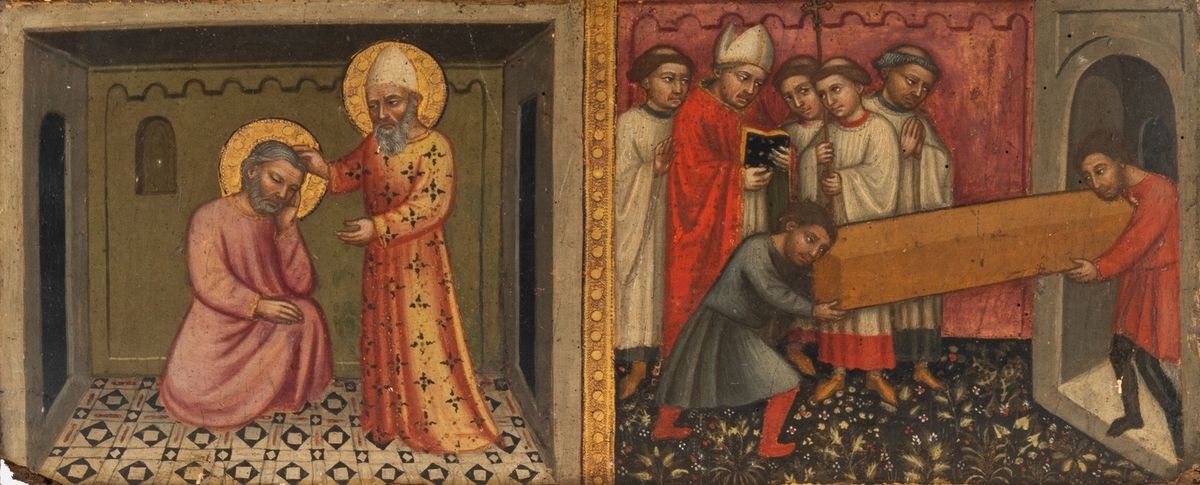Description
BOLOGNA SCHOOL circa 1335 Two scenes from the life of a saint Predella element of an altarpiece Height: 23 cm Width: 57.5 cm Egg painting on rectangular wooden panel The execution of this panel, the subject of which we have not been able to determine, should be seen in the context of the Emilian artistic milieu of the early fourteenth century. Rather than the easel works of the great artists who were to make Bologna famous from 1340 onwards, such as Vitale da Bologna, we must situate the activity of its author, earlier, around the workshops of illuminators who worked for the various ecclesiastical authorities in the first three decades of the century (cf. M. Medica, in Giotto e le arti a Bologna al tempo di Bertrando del Poggetto, exhibition Bologna, Museo Civico Medievale, 3 December 2005 - 28 March 2006, pp. As with the latter, the influence of Giotto in the frescoes of the Arena chapel in Padua (1305) can be seen in the use, albeit rudimentary, of the "giottesque box" for the staging of the characters and the narrative, anecdotal tone, in which simplicity, rusticity and restlessness animate the action, intrinsic characteristics of the art of Bolognese illuminators. Particularly noteworthy is the short canon of the characters, the broad strokes of the draperies, the lively gaze of the faces, animated by large elongated eyes whose black cornered pupils, standing out against the white sclera, create particularly lively expressions. It is striking to find in the sleeping character the alter ego of the dreaming St. Joseph of the Nativity (private collection, cf. Medica, op. cit. repr. p.47,156), part of the predella of the large altarpiece sculpted by Giovanni di Balduccio (a Pisan artist from around 1290-1339) for the chapel of the papal palace in the Porta Galliera in Bologna, a building that was destroyed in 1334 during internal struggles. The attitude of the two figures, the broad features of the faces, the similar treatment of the hair are all elements that allow us to think that the author of our panel saw Balduccio's altarpiece, not in situ, but more certainly when it was transported in 1335 on the high altar of the church of San Domenico in Bologna (cf. Medica, op.cit. p.48) This lot is described by the Cabinet Turquin, Paris.
137
BOLOGNA SCHOOL circa 1335 Two scenes from the life of a saint Predella element of an altarpiece Height: 23 cm Width: 57.5 cm Egg painting on rectangular wooden panel The execution of this panel, the subject of which we have not been able to determine, should be seen in the context of the Emilian artistic milieu of the early fourteenth century. Rather than the easel works of the great artists who were to make Bologna famous from 1340 onwards, such as Vitale da Bologna, we must situate the activity of its author, earlier, around the workshops of illuminators who worked for the various ecclesiastical authorities in the first three decades of the century (cf. M. Medica, in Giotto e le arti a Bologna al tempo di Bertrando del Poggetto, exhibition Bologna, Museo Civico Medievale, 3 December 2005 - 28 March 2006, pp. As with the latter, the influence of Giotto in the frescoes of the Arena chapel in Padua (1305) can be seen in the use, albeit rudimentary, of the "giottesque box" for the staging of the characters and the narrative, anecdotal tone, in which simplicity, rusticity and restlessness animate the action, intrinsic characteristics of the art of Bolognese illuminators. Particularly noteworthy is the short canon of the characters, the broad strokes of the draperies, the lively gaze of the faces, animated by large elongated eyes whose black cornered pupils, standing out against the white sclera, create particularly lively expressions. It is striking to find in the sleeping character the alter ego of the dreaming St. Joseph of the Nativity (private collection, cf. Medica, op. cit. repr. p.47,156), part of the predella of the large altarpiece sculpted by Giovanni di Balduccio (a Pisan artist from around 1290-1339) for the chapel of the papal palace in the Porta Galliera in Bologna, a building that was destroyed in 1334 during internal struggles. The attitude of the two figures, the broad features of the faces, the similar treatment of the hair are all elements that allow us to think that the author of our panel saw Balduccio's altarpiece, not in situ, but more certainly when it was transported in 1335 on the high altar of the church of San Domenico in Bologna (cf. Medica, op.cit. p.48) This lot is described by the Cabinet Turquin, Paris.
